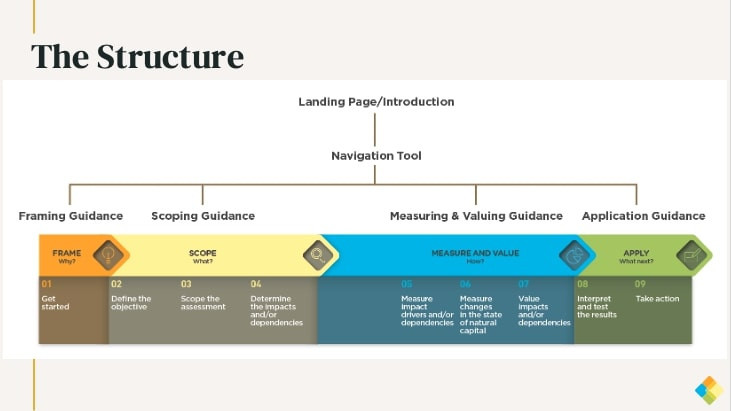For companies, the reporting of biodiversity impacts is here. The Corporate Sustainability Reporting Directive (CSRD) has been adopted by the European Council and affects some 50,000 companies in Europe. (And small companies not directly in scope are nevertheless advised to pay attention, ). In parallel, a taskforce has sprung up to develop a risk management and disclosure framework in which to complete such reports, i.e. the Taskforce on Nature-related Financial Disclosures (TNFD).
During last week’s IMS Luxembourg webinar, Justine Saunders of the Netherlands-based Capitals Coalition presented attendees with something that might be relevant in the wider project of biodiversity impact reporting: a biodiversity guidance navigation tool.
“[Regular annual reporting on biodiversity] will be quite involved and quite a lot of work,” says Saunders in an interview, adding that companies will have to learn how to do it quickly.
The main challenge, she explains, is that biodiversity is site-based. “To get site-level information updated regularly, on an annual basis--that’s quite difficult.”
While guidance from the TNFD is coming, the time has come for companies to, if they haven’t already, get on board with larger shifts in thinking.
New paradigm
Saunders describes how a capitals approach--i.e. a combination of produced capital, social capital, human capital and natural capital--requires new thinking: “You [need to] start to think in terms of systems, not silos,” she says. “The valuation side of it becomes really important. It’s about both impacts and dependencies.”
The current norm is to consider, first and only, the impact on the company. Saunders gives an example of a firm that worries about its effects on a local forest in terms of how its customers see them. “But very rarely are we looking at anything outside and thinking: what’s our impact on society in general?”
And nearly every company, she points out, relies on natural capital somewhere in their activities, presence or supply chain. “And they need to understand that risk.”
The tool that Capitals Coalition has developed is designed to take decision-makers through a process that starts with defining an objective and ends with taking action.

An overview of the Biodiversity Guidance Navigation Tool created by the Capitals Coalition. Image: Capitals Coalition
Regarding step three, for example, “Scope the assessment”, Saunders mentions questions like What environmental features do you need to consider? What aspects of the business do you need to consider? How far down supply chains and the lifecycle of the business do you need to assess? etc. And although the process appears linear, she stresses, it’s designed to be iterative. “There’s always something really important that wasn’t scoped, and you’ll need to go back and reassess it.”
In the larger picture, the idea is for companies to understand their impacts and dependencies not only to assess risks but also to identify opportunities. “It’s not just a negative thing,” says Saunders. “There could be opportunities as well [like] better targeting your investments.”
Industry trend
“There has definitely been a ramping up of interest,” says Saunders of companies looking into biodiversity impact measurement and reporting.
“Maybe ten years ago there were only a handful of major players who were thinking about this, because they wanted to be at the forefront… but now we’re starting to see more businesses coming on board and particularly more small/medium enterprises,” she comments, adding that getting investors on board too means that everyone will be affected--and will need to start reporting on the same frameworks.
Saunders stresses that, realistically, companies will only complete biodiversity assessments if there is a benefit for the company, hence the stress on opportunities that might be available.
But, in the larger picture, she is hopeful. “I think people can get discouraged that it’s too hard,” she comments. “But I think having all these frameworks and standards coming together, [and] the case studies of companies who have done this, hopefully gives others hope that it is achievable--and that particularly if we work together and share data and understanding, it’s not as daunting a prospect.”
“It’s doable. It’s doable!”
